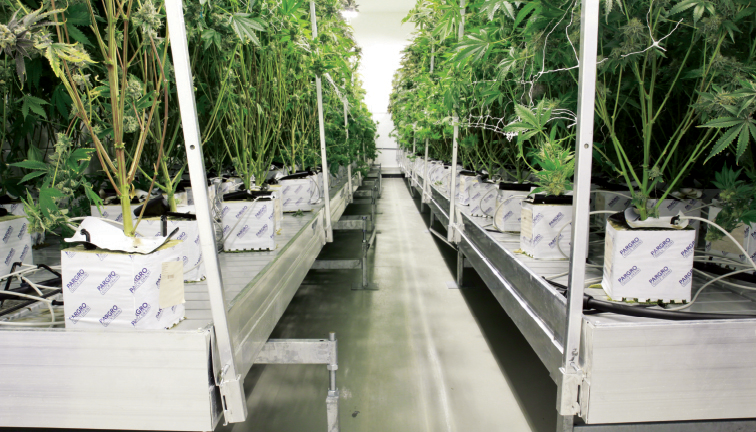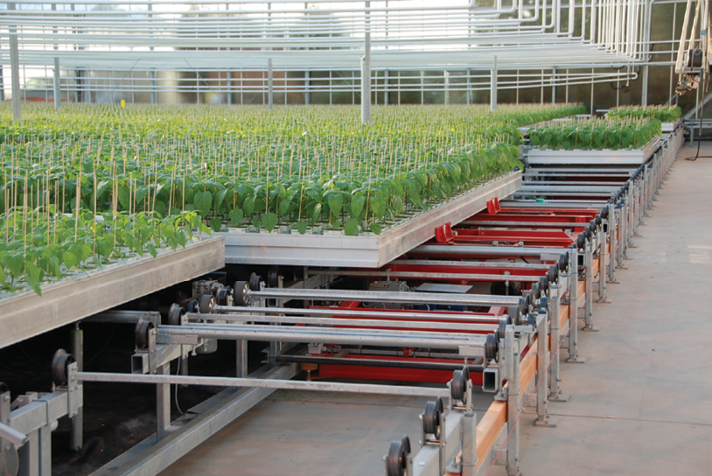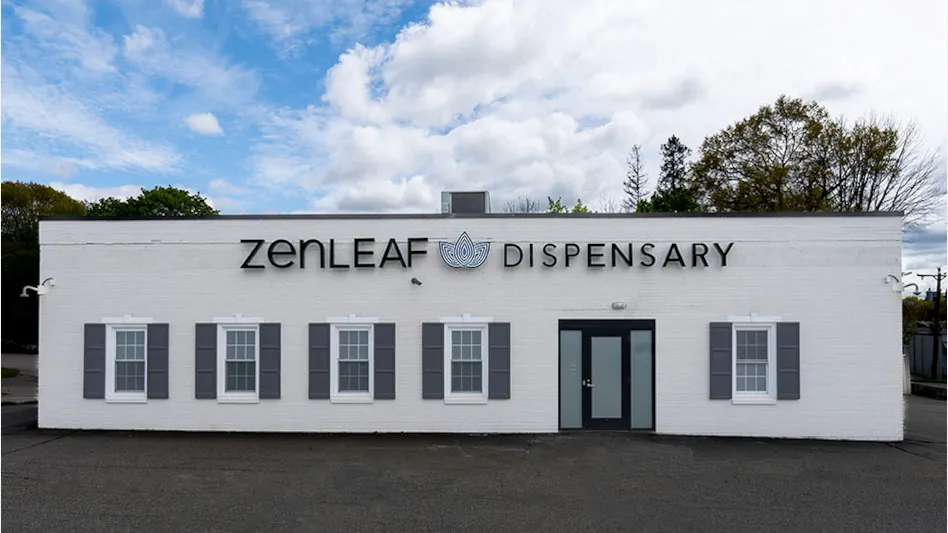
Motivated by lower prices and shrinking profit margins on cannabis, many commercial growers are eying improvements to their bench systems as a way to maximize efficiency. Because every aspect of cultivation is connected to that choice, it’s a logical place to start.
Whether they are improving or expanding an existing facility, or building a new one, growers who are contemplating such a decision naturally want to consider the latest technology. They may be surprised to learn that the best solutions aren’t really new.
“The new technologies in benching solutions for the cannabis market are products we’ve had for probably about the past 20 years in the horticulture market,” says Ron Berkhout, a veteran of the horticulture industry who represents VRE Systems. The Canadian company serves cannabis and other horticultural growers, helping them select the right equipment for their operations.
The weakest link in efficiency is often a stationary table system, which is still used extensively in the commercial cannabis market. They are the simplest and, at $8 to $10 per square foot, the least expensive. But, because they are designed to stay in one place, there is a limit to what growers can do with them.
For that reason, some cannabis growers are ready to consider rolling and mobile benching systems. Rolling bench systems typically cost $15 to $17 per square foot. For approximately $28 to $30 a square foot, a mobile system can provide even greater levels of efficiency.
In some applications, tables are customized with removable, adjustable-height net supports to protect top-heavy growth from stem damage. Many bench systems are height-adjustable, as well.
Mobile Vs. Rolling Bench Systems
“Rolling benches can increase grow space by 60 percent,” Berkhout says. For a 20- to 25-percent increase in cost, it isn’t uncommon to see a return on investment in less than a year, he says.
Rolling bench systems also eliminate the need to reserve space for stationary aisles, leaving more room for canopy. Tabletops slide from side-to-side, butting into each other to make room for a single aisle that can be relocated wherever it’s needed.
Another option for growers is installing mobile table systems, according to Zev Ilovitz, president of EnviroTech Cultivation Solutions, a California-based company that does design/build work, including engineering, design, supply, construction and integration.
Sometimes called palletized or container systems, mobile systems have tabletops that are free of the substructure. Mobile bench systems enable cultivators to move plants collectively from point to point at each growth stage.
They can reduce labor costs by as much as 70 percent, according to Ilovitz. “We have a client in Washington state that runs 20,000 square feet of cultivation with three employees,” he says. “It’s not just that you need fewer people to move the plants around. The process allows you to maintain a small, consistent workforce, rather than having peaks and valleys, going from massive harvests to no work for two months.” The mobile environment keeps plants moving continuously through each growth stage, so it streamlines labor during a perpetual harvest.
Since mobile bench systems bring plants to people rather than the other way ar ound, they eliminate many of the risks of introducing pests and pathogens—risks which are increased when people frequently are moving in and out of the environment.
“You can have all the disinfected rooms and make people wear all the hazmat suits you want, but the worst carriers of pathogens and microbials that could be harmful to the product are people,” says VRE’s Berkhout. “The fewer people in a grow room, the less the chance of disease.”
“There is next to no reason not to like a mobile system,” Ilovitz says. “They can work with soil, hydroponics and pretty much everything, but they tend to be more suitable for a sophisticated facility, and they need to be thought out and planned properly.”
Ilovitz considers mobile systems such a critical factor of long-term success in the cannabis market that he usually works closely with growers to determine if a mobile system is viable. That can only be decided on a case-by-case basis because every product needs to work together in an integrated way. “We need to understand their processes and know everything about the facility and the flow of the system,” he says.

New Facility = Blank Slate
While rolling bench systems can be added at any time, growers interested in mobile systems typically need to implement them in the construction phase as part of a new facility or expansion.
“I wouldn’t swing a single hammer before the whole thing is designed,” says Mike Kupferman, chief cultivation officer at Holistic Industries, a commercial grower who started growing medical cannabis in two facilities in Washington, D.C., and recently expanded with new facilities in Monson, Mass., and Capitol Heights, Md.
For the Massachusetts and Maryland facilities, Kupferman chose mobile, automated bench systems purchased through EnviroTech, which is a supplier for the manufacturer KG Systems. Unlike his Washington, D.C., facilities, which were already set with small rooms, the new sites were built from scratch, giving him the freedom to choose almost anything. “I have an engineering background, so from the beginning, I was set to figure out the most efficient use of space,” he says.
A mobile system has container tops that move side-to-side on a conveyor frame. Plants can be transported into individual rooms on a pipe or monorail system. These systems can also be automated by software or manual programming.
Kupferman and his team worked with EnviroTech to design a mobile system with lifts that carry trays from the first to the second floor.
“We’re able to do everything downstairs and move trays upstairs—a large increase in production because the entire upstairs is flowering,” Kupferman says. “Basically, you can have two systems going at the same time with just one veg room. Upstairs, everything is flower. When you’re done flowering, you put them back on the lift and send them downstairs to harvest.” Plants at the end of the system slide out into harvest once a week; those at the beginning of the process advance.
Kupferman likes the way the mobile system simplifies irrigation and pest management, as well. “When you set up an irrigation system, and you have plants maturing in the same place, you have to constantly alter what nutrients are going to that place based on the maturity of the plant,” he says. “In a system like this, the zones are preset, and the plants get the nutrients you desire.”
Overspray of pesticides is non-existent because plants are grouped by growth stage, so older plants are separated from younger plants that might require spraying, says Kupferman. “Once you automate everything, it organizes your system better and saves you from making … mistakes,” he says.
Kupferman acknowledges that their choice wasn’t the cheapest option. “I think the biggest thing that would keep someone from doing it is the capital investment,” he says. Mobile systems may not be feasible for growers with numerous, small grow rooms, but that doesn’t mean they are off-limits for smaller operations with the right conditions.
Berkhout of VRE Systems has implemented mobile bench systems for facilities ranging from 10,000 to 350,000 square feet. “A small system can be built onto like Legos, and become very cookie-cutter,” he says. “In fact, that’s how a lot of traditional greenhouses started—with a small footprint that they kept expanding. I think that model translates even better to the cannabis industry because a lot of these growers are starting small with big dreams for expanding in the future.”

Explore the September 2017 Issue
Check out more from this issue and find you next story to read.
Latest from Cannabis Business Times
- Rescheduling Would Have Saved Verano $80M in 2023 Tax Payments, CEO Says
- Aurora Marks 1st Medical Cannabis Shipment to New Zealand Market
- Where All 100 US Senators Stand on SAFER Banking Act
- Blumenauer Unveils Legislative Blueprint, Additional Administrative Action Needed Following Rescheduling
- Cannabis Rescheduling FAQ: What Now?
- From Custodian to Cultivation Supervisor
- California City in Cannabis Retail Desert Welcomes 1st Dispensary
- US Senate Democrats Forgo Addressing Intoxicating Hemp in 2024 Farm Bill Summary





